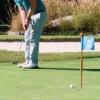-
Posts
12 -
Joined
-
Last visited
Reputation Activity
-
 Greenside got a reaction from PMookie in Poll: Spikes or Spikeless?
Greenside got a reaction from PMookie in Poll: Spikes or Spikeless?
Spikes only - it prevents disaster.
Tried cute plastic nubbies circa 1998 when metal spikes were being phased out. Was taking a golf lesson, my left foot gave way with nubbies, I did a standing split, tore a thigh muscle, and couldn't exercise at all for 6 weeks. Needless to say, golf season was shot.
Courses I play on normally have a few holes with hillside fairways or greens that are cliff hangers. In last decade:
Playing a casual round in traction sole cross-training shoes, left a ball halfway up a steep bunker bank. Had to take unplayable lie penalty because I couldn't get a stance on the hillside. A beginner I was playing with was playing in street shoes with softish shoes. Takes a shot from a damp area in the rough, his foot slips and he sprains his wrist breaking his sprawl. Hitting out of a cliffhanger pot bunker, one foot below and the other above, I bail out backwards and twist my knee badly. I withdraw after ninth hole. And this was with decent soft spikes. Our area has two fairly flat par 3 courses where I might play with spikeless or even cross-train shoes. But everywhere else I want spikes!
-
 Greenside got a reaction from BIG STU in Favorite Non-Urethane Ball?
Greenside got a reaction from BIG STU in Favorite Non-Urethane Ball?
I have long been searching for the ideal mid-spin ball.
I did a field test a couple of years back on the second-phase e6 ball. It performed similar to the newer two-piece Callaway SuperSoft. Good overall ball, but little or no spin for shots inside 30 yards.
The three-piece Callaway SuperHot gives me better close-in spin. Has a softer ionomer cover. I can't back it up, but I get accurate one-hoppers. Canned three LW shots last summer for birdies. And, part of stopping power is descent angle. Moving to a LW for most greenside shots has helped with control.
This past summer I found that I had accumulated five sleeves of Srixon Q-Star Tour golf balls, so I gave them a try. The three-piece QST has a urethane cover with "Spin Skin" coating, which enhances short-game spin. But it comes in ~ $34 a dozen, some $10 to $15 less per dozen than ProV1 and its upscale rivals.
QST is supposed to be a lower-spin ball for full shots, but it launches high so descent angle is steeper and I can get it to hold greens. Again, I don't usually back it up, but can get stable one-hopper on clean strike. And, my Mav MAX irons have fairly high lofts, so this helps with spin and descent angle.
Note that I play chip and run often greenside, and will often use a 7-iron bump shot inside 60 yards on windy days. So, a ProV1 type ball would make it more difficult to get runout when I wanted it.
@Tiftaaft, I hope you don't rate me as off-topic because of QST mention. It's a urethane ball, it works for me, but it doesn't cost $50 a dozen.
-
 Greenside got a reaction from PhilM75072 in Poll: Spikes or Spikeless?
Greenside got a reaction from PhilM75072 in Poll: Spikes or Spikeless?
Spikes only - it prevents disaster.
Tried cute plastic nubbies circa 1998 when metal spikes were being phased out. Was taking a golf lesson, my left foot gave way with nubbies, I did a standing split, tore a thigh muscle, and couldn't exercise at all for 6 weeks. Needless to say, golf season was shot.
Courses I play on normally have a few holes with hillside fairways or greens that are cliff hangers. In last decade:
Playing a casual round in traction sole cross-training shoes, left a ball halfway up a steep bunker bank. Had to take unplayable lie penalty because I couldn't get a stance on the hillside. A beginner I was playing with was playing in street shoes with softish shoes. Takes a shot from a damp area in the rough, his foot slips and he sprains his wrist breaking his sprawl. Hitting out of a cliffhanger pot bunker, one foot below and the other above, I bail out backwards and twist my knee badly. I withdraw after ninth hole. And this was with decent soft spikes. Our area has two fairly flat par 3 courses where I might play with spikeless or even cross-train shoes. But everywhere else I want spikes!
-
 Greenside got a reaction from HAC in Favorite Non-Urethane Ball?
Greenside got a reaction from HAC in Favorite Non-Urethane Ball?
I have long been searching for the ideal mid-spin ball.
I did a field test a couple of years back on the second-phase e6 ball. It performed similar to the newer two-piece Callaway SuperSoft. Good overall ball, but little or no spin for shots inside 30 yards.
The three-piece Callaway SuperHot gives me better close-in spin. Has a softer ionomer cover. I can't back it up, but I get accurate one-hoppers. Canned three LW shots last summer for birdies. And, part of stopping power is descent angle. Moving to a LW for most greenside shots has helped with control.
This past summer I found that I had accumulated five sleeves of Srixon Q-Star Tour golf balls, so I gave them a try. The three-piece QST has a urethane cover with "Spin Skin" coating, which enhances short-game spin. But it comes in ~ $34 a dozen, some $10 to $15 less per dozen than ProV1 and its upscale rivals.
QST is supposed to be a lower-spin ball for full shots, but it launches high so descent angle is steeper and I can get it to hold greens. Again, I don't usually back it up, but can get stable one-hopper on clean strike. And, my Mav MAX irons have fairly high lofts, so this helps with spin and descent angle.
Note that I play chip and run often greenside, and will often use a 7-iron bump shot inside 60 yards on windy days. So, a ProV1 type ball would make it more difficult to get runout when I wanted it.
@Tiftaaft, I hope you don't rate me as off-topic because of QST mention. It's a urethane ball, it works for me, but it doesn't cost $50 a dozen.
-
 Greenside got a reaction from Quigleyd in NPG Episode 39: Has Callaway Golf Lost Their Mojo?
Greenside got a reaction from Quigleyd in NPG Episode 39: Has Callaway Golf Lost Their Mojo?
@Quigleyd,
I found a Stock vs. Premium shaft thread from February.
https://forum.mygolfspy.com/topic/36489-stock-vs-premium-shafts-from-the-same-oem/?do=findComment&comment=596553
The Ventus shaft is an example. Basically, the aftermarket Ventus contains the Pitch 70 carbon fibers which give it an extra low-torque, low-spin profile. The "made for" Ventus lacks the Pitch 70 weave.
One thread respondent @chisag is a +1.2 HDCP who gives personal examples of the differents. He notes that for those with medium swing speed, the "made for" structure is probably a good thing. And, I'm one of those guys with sub-90 MPH driver CHS that would benefit from the "made for" shaft version. Those {low torque + low spin} shafts give me superb line, but fly low and don't carry 200 yards. I need adequate spin to get the ball launched properly.
chisag further noted that along with swing speed, how aggressive you are at transition affects your Ventus shaft choice.
If you want to make the case that the whole aftermarket vs. made-for reality is fuzzy to most golfers, I agree. But, average golfers like me can do quite well with "made for" shafts - as long as we select them through fitting.
-
 Greenside reacted to Quigleyd in NPG Episode 39: Has Callaway Golf Lost Their Mojo?
Greenside reacted to Quigleyd in NPG Episode 39: Has Callaway Golf Lost Their Mojo?
The current best example is the ventus shaft in the sim drivers. It is not the same shaft as the after market shaft. It has the same name, same bend profile but is. It the same construction, not the same materials, lacks the velocore. Hence watered down.
-
 Greenside got a reaction from MattWillGolf in NPG Episode 39: Has Callaway Golf Lost Their Mojo?
Greenside got a reaction from MattWillGolf in NPG Episode 39: Has Callaway Golf Lost Their Mojo?
On the discussion about "made for" vs. "after market" shafts: I have been fit for drivers three times since 2009, and in all cases one of the stock shafts gave me best or "near best" numbers. Granted, I only have 87 MPH driver clubhead speed. But, I'm not going to pay an extra $350 upcharge for a driver shaft that gives me six more yards in distance.
A related issue is swing precision. My swing is not as precise as someone who is a 2 HDCP. Thus, they would likely benefit more from the narrow performance window of a-m than me.
Also, the "made for" shafts, as you correctly remarked, are often last year's after-market shaft. This is like in the early 2000s in personal computers: last year's "screamin' machine" is this year's stock model. The year 2 item, be it a computer or golf shaft, has lower costs in part because of economies of scale and leveraging past R&D.
Related topic: you needed to get a better handle on explaining fixed costs vs. variable costs, and economies of scale. One of the biggest fixed costs is R&D, as you all have noted. If we have the R&D all done for a Speeder X1 after-market, we may tweak it as a shaft profile that fits a lot of people that will play our new driver, and call it the Speeder X2A. But, as a "made for" shaft we will sell 20 million of them rather than 1 million of last year's a-m Speeder X1. The economies of scale for the 20-fold leap in numbers sold makes for a lower per-unit cost.
Finally, will a respected shaft maker risk putting junk materials into a "made for" shaft?
When someone shows me an after-market shaft, once I see them hit the ball, I sense the a-m benefit is often 80% prestige and 20% performance.






